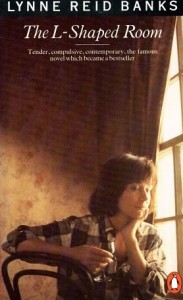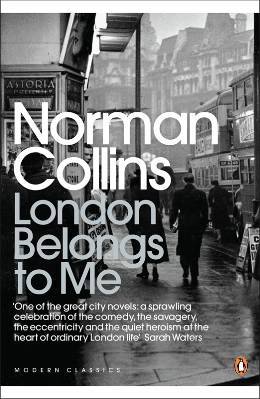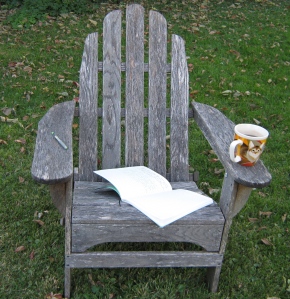Yup, it’s tea time in the back yard.
I’m calmly drinking my home-brewed tea after a week of gulping Grande javas at sidewalk cafes. My home cafe is like Starbucks without the Starbucks, or Costa without the Costa. I love the beautiful parks and squares in London, but it is really better to sit under a tree in your pajamas and drink coffee out of a kitschy cat mug.
And so as I read Lynne Reid Banks’s elegant, moving novel, The L-Shaped Room, a 1960 feminist classic about an unmarried pregnant woman in her late twenties, I not only admired the exquisite writing but noted how much coffee and tea is imbibed.
 The narrator, Jane Graham, a former actress who works in PR, is confused and sad and daren’t tell her friends about her pregnancy. Instead, she throws herself upon the expertise of middle-aged men. A Harley Street doctor assumes she will want an abortion. And when she tells her father she is pregnant, he says she is no better than a street-walker. Fed up with the patriarchy, Jane leaves home and moves into a seedy L-shaped room in a dilapidated house.
The narrator, Jane Graham, a former actress who works in PR, is confused and sad and daren’t tell her friends about her pregnancy. Instead, she throws herself upon the expertise of middle-aged men. A Harley Street doctor assumes she will want an abortion. And when she tells her father she is pregnant, he says she is no better than a street-walker. Fed up with the patriarchy, Jane leaves home and moves into a seedy L-shaped room in a dilapidated house.
We tend to forget the stigma of unwed pregnancy, since it is celebrated in sitcoms and movies (Friends, Mom, The Switch, etc.). Abortion is still a guilty secret, because of the mad Fundamentalists who picket and protest Planned Parenthood and abortion clinics. At the moment, funding for Planned Parenthood is under attack by the Republicans. It wearies me to think my days as a volunteer coordinator for NARAL in the 1970s made so little difference.
But I am fascinated by this novel, not because of the pregnancy, but because I love reading about Jane’s cheap digs and the people who rent rooms there. They band together, as people do when they have a bad landlady and bedbugs terrorize them. Jane makes friends with Toby, a witty writer who would rather talk to Jane than write; John, a black jazz musician who does needlework ; the two kind prostitutes, Jane and Sonia; and Mavis, the retired costumer for a theater company. John is always making tea and meals for Jane and Toby. Mavis makes the best coffee. Jane loves coffee, and also drinks it at Frank’s, a neighborhood cafe.
In college we all rented rooms unless we had trust funds. (Those with trust funds owned their own houses, and generously offered to let us live there, but then you had to buy Christmas trees with them… and it wasn’t worth it if you were depressed). I could barely squeeze a bed and tiny bookcase into my room, but it was my own. All of us got to know each other in the shared kitchen, and we went to discos together (such bad music!), sunbathed on the roof, and occasionally shared Ramen noodles and cake mixes.
Jane’s house was bigger than our three-story. Jane says,
My room was five flights up in one of those gone-to-seed houses in Fulham, all dark brown wallpaper and peeling paint outside. On every second landing was a chipped sink with one tap and an old ink-written notice which said ‘Don’t Leave Tap Dripping.’ The landing lights were the sort that go out before you can reach the next one. There were a couple of prostitutes in the basement; the landlady had been quite open about them. She’d pointed out that there was even an advantage to having them there, namely that nobody asked questions about anybody.
I love this kind of book. So I’ve been thinking about other novels where characters live in lodging, and please let me know your favorites!
 Norman Collins’s London Belongs to Me. In this charming novel, Collins interweaves the stories of the residents of Number 10 Dulcimer Street in London. Th stingy landlady, Mrs. Vizier, broods in her basement apartment, wondering if any of her tenants are bringing the tone of her house down. But her tenants are a plucky lot, and they support one another through innumerable troubles, including a murder. (I wrote more about this novel here.)
Norman Collins’s London Belongs to Me. In this charming novel, Collins interweaves the stories of the residents of Number 10 Dulcimer Street in London. Th stingy landlady, Mrs. Vizier, broods in her basement apartment, wondering if any of her tenants are bringing the tone of her house down. But her tenants are a plucky lot, and they support one another through innumerable troubles, including a murder. (I wrote more about this novel here.)- Monica Dickens’s The Heart of London. I read this years ago, so here is an excerpt from the Kirkus Review: “The happenings in an urban section of London, Cottingham Park, have for their background the threats and rumors of the widening of the road through, of an expressway and the demolition involved — all of which become a reality, and link and interlink the of a large collection of people.
- The Yacoubian Building by Alaa-Al-Aswany. From the Amazon description:
“All manner of flawed and fragile humanity reside in the Yacoubian Building, a once-elegant temple of Art Deco splendor now slowly decaying in the smog and bustle of downtown Cairo: a fading aristocrat and self-proclaimed “scientist of women”; a sultry, voluptuous siren; a devout young student, feeling the irresistible pull toward fundamentalism; a newspaper editor helplessly in love with a policeman; a corrupt and corpulent politician, twisting the Koran to justify his desires.”These disparate lives careen toward an explosive conclusion in Alaa Al Aswany’s remarkable international bestseller. Teeming with frank sexuality and heartfelt compassion, this book is an important window on to the experience of loss and love in the Arab world.”
And that’s all she wrote for now! Please let me know your favorite lodgings in literature!


I keep hearing good things about the Banks book – I know Simon raves about it. I’ll just have to get myself a copy…. 🙂
LikeLike
It’s a splendid book! I first read it in my twenties and was so happy to find it at a used bookstore because it is out of print in the U.S. It seems a natural for Virago or Persephone.
LikeLiked by 1 person
Lodgings. There is a lesser-known Graham Greene, England Made Me, which has lodgings and the social meaning of living in them. It has been years since I read Mural Sparks’ The Girls of Slender Means, but didn’t “the girls” live together in some sort of lodging?
LikeLike
Brilliant suggestions! I don’t know the Graham Greene but shall look for it after my book-buying ban is lifted. Muriel Sparks is certainly a natural for this kind of thing. I’m sure of the girls of slender means did live in lodgings!
LikeLike
I saw the fine film made of The Yacoubian Building; every time I see the book, I wonder if it is as good, or possibly even better. As for books on lodgings, there are the disturbing writings of Jean Rhys. Good Morning, Midnight, which I found deeply affecting. It is set in Paris, where an aging Sasha tries to pull herself together but is instead reminded of her traumatic past. In Voyage in the Dark, an earlier novel, we get insight into her protagonists earlier days in London lodgings. If you haven’t read it, it ends with an abortion, in the 30s if I remember correctly.
Elaine
LikeLike
Oh, I haven’t seen the film!. Both my husband and I loved the book,so two thumbs up. It has been many years since I read Rhys, and I would love to go back to her books. I don’t remember the details of any of her novels, but those heroines do live in depressing places. Poor Sasha!
LikeLike
I loved the descriptions of lodgingd in Barbara Pym’s novels. They have a function as well: they are here to signify what kind of lives and and kind of persons lead and are the characters – with epiphanies over a sink while washing up, for instance. Houses can be at the heart of a novel as with “Howards End” with its town and country homes, or “Brideshead Revisited”. At one point, I read a lots about college rooms in Oxford and Cambridge. Nowadays, some “light” novels by Alexander MacCall Smith turn around the lives of people living in one House in series based in Edinburgh and London. And in French, there is “La Vie, Mode d’Emploi” by Georges Pérec that was the consecrartion of his writing career: he explores methodically the life of the inhabitants of a Parisian building with a kind of mystery at his heart. I don’t know if it has been translated in English. Pérec belonged to an experimental group of French writers. I forget other books are there are plenty where lodgings (in a genereic sense) have a functional reason in the novels.
LikeLike
Yes, Barbara Pym does write about characters in rented rooms. And I love what you say about the meaning of houses. Forster’s Howards End has had a profound influence on me over the years. I still want a wych-elm with pigs’ teeth on it! I have never read Perec, but this one sounds good.
LikeLike
I was thinking about Pym as well, but there is also Doris Lessing’s ‘The Good Terrorist’ which I think is one of her best.
I really enjoy Banks work. Have you read her novels for teenagers ‘One More River’ and ‘Broken Bridge’, which address the conflict in the Middle East? If not, I can really recommend them. Unfortunately, I met the lady herself some years ago and was not so impressed 😦
LikeLike
Yes, Doris Lessing does write about people who are down-and-out and living in squats and rooms. Good suggestion! Oh, I’d love to read more Banks, but I don’t think she is in print here. I’ll add these to the TBR. Meeting writers can be strange. I’ve had good encounters and bad… 🙂
LikeLike
What a fantastic theme for a post! I’ve heard of The L-Shaped Room, and now I would love to read it. I’ve only ever read Lynne Reid Banks’ children’s books when I was little, so it will be great (and interesting) to read her adult books. The other books you have listed also sound intriguing. Many thanks for this!
LikeLike
Oh, you’ll love The L-Shaped Room! I haven’t read her children’s books, but there are two sequels to “L-.” I’m glad you enjoyed the post. So many good books are recommended in the comments that I should really make a separate post and list them!
LikeLike
Of her children’s books the Magic Hare stories are just lovely. I never really liked the Indian in the Cupboard!
LikeLike
Oh, thank you! I’ll look for the Magic Hare!
LikeLike
I feel as though I should be able to come up with more suggestions but they’re slipping my mind at the moment — the only one that I can think of is a book I haven’t read, Breakfast at Tiffany’s by Truman Capote. I’ve seen the movie and understand that the book is rather different, but I imagine it would still qualify for this category.
LikeLike
Yes! Good one! I haven’t thought of Breakfast in Tiffany’s in years. It’s a nice, short books, and that wonderful movie…
LikeLike
I haven’t read The L-Shaped Room, but will keep an eye out for it. My favourite lodgings are in Have His Carcass, when Harriet Vane goes to live in the rooms formerly occupied by the murder victim whose corpse she found and divides her time between code breaking and reading Ruritanian novels, and D.E. Stevenson’s The Blue Sapphire and The House on the Cliff, which feature the same heart -of-gold landlady, Miss Martineau, who knows all about the stage. So does Harriet’s landlady, who used to be in a circus, if I remember correctly!
LikeLike
I love the Harriet Vane! Great suggestion! That is one of my favorites. I’m not up on my DES, and that reminds me, I should read her again. I do remember lodgings in Island Magic. I hope I’m not mixing up that title with an Elizabeth Goudge.
LikeLike
Pingback: Summer Reading Binge: Lose Yourself in a Trilogy or Quartet – mirabile dictu